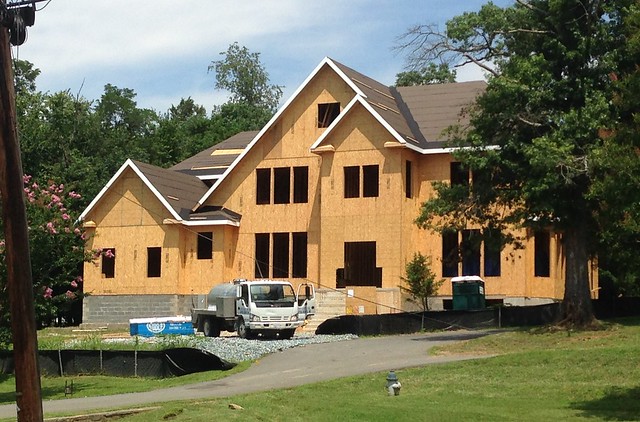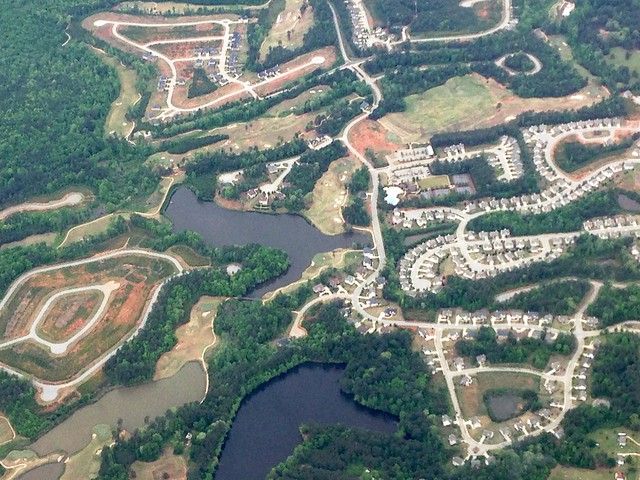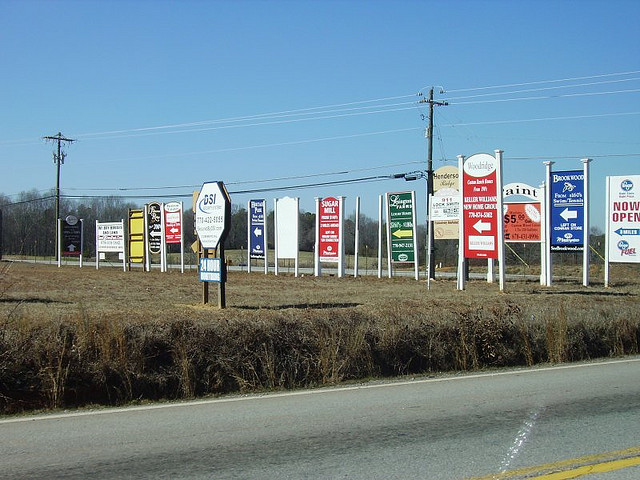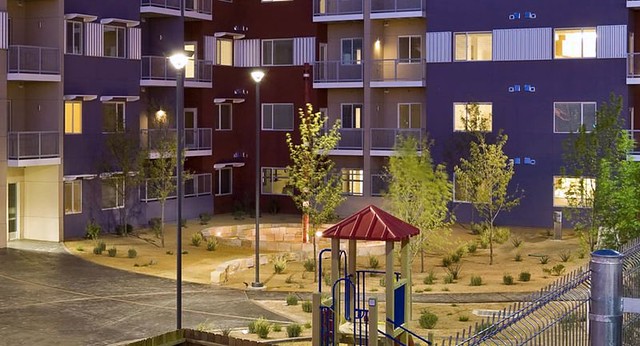What the latest housing data mean for the environment

Posted August 1, 2014 at 2:00PM
Few things have been as simultaneously destructive to the natural environment, the economy, and our social fabric as the tidal wave of suburban sprawl that washed over the US in the late 20th century. Driving rates and related emissions soared as we had to drive longer and longer distances to get anywhere; pavement gobbled up watersheds and ecosystems; infrastructure construction and maintenance costs threatened to bankrupt governments; and inner-city populations languished as investment and opportunity fled for (literally) greener pastures.
As a result, environmentalists and city advocates have taken comfort in recent trends that have shown a resurgence in cities and inner suburbs, as outer suburban subdivisions lost more value in the recession than did urban locations and average new home sizes began to shrink. Demographic trends have suggested that these welcome changes are likely structural, not just temporary products of a slumping economy.
There’s still reason to feel optimistic about cities over the long run, but a range of new housing data suggest that what’s really going on in the marketplace may be more complex and mixed than some of us had come to believe.
Home sizes growing again
For example, the average new single-family home size at the end of 2013 had strongly rebounded to a record 2,679 square feet, 180 square feet bigger than in 2007 before the recession. (American houses are markedly gluttonous when it comes to floor space. The average new home size in Britain is only 818 square feet; in Canada, it is 1,948 square feet.)
According to census data, about 48 percent of new homes in 2013 had at least four bedrooms, up from 34 percent in 2009. The share of new homes with at least three full bathrooms rose to 35 percent from 23 percent in 2010, and the number with three-plus car garages increased to 22 percent from 16 percent in 2010. Also, 60 percent of new homes in 2013 were two-story, single-family properties – an increase from 51 percent in 2009. It’s a safe bet that most of these new houses are being built in outer suburbs, contributing to sprawl.
On the other hand, the portion of the market claimed by supersized houses of 3,000 square feet or more is definitely shrinking, down to only 31 percent from a high of 45 percent at the peak of the housing boom in 2007, writes Katherine Salant in the (Sarasota) Herald-Tribune. Industry spokespeople cited in Salant’s article suggest that the apparent surge in average size of new homes despite the loss of market share for the largest models may be due to the current difficulty of first-time buyers, a typical market for smaller homes, in obtaining financing.
Millennials postponing buying
On the subject of would-be buyers, Washington Post writer Carol Morello confirms what many of us already knew anecdotally: Many more young adults are now living with their parents rather than themselves entering the housing market, “a striking reversal of a pattern that held through most of the 20th century.” Since young adults are also primarily responsible for the trend toward more downtown living, this suggests that the degree of recovery of some inner cities from decades of disinvestment could be dampened as a result, especially in weak and mid-market regions. The primary reasons for Millennials’ staying out of the market are a lack of jobs and the burden of high student debt, according to Lawrence Yun, chief economist at the National Association of Realtors, quoted in an Associated Press story.
Lest you think that the uptick in multi-generational living is raising the average size of households, think again: Between 1973 and 2013, the average American household shrank from 3.01 to 2.54 persons; new homes give Americans more than 1,000 square feet per family member, on average. That’s roughly twice as much space as we had in 1973, writes Henry Grabar in Salon.
The effect on the environment from more multi-generational living is mixed. Young adults living with their parents aren’t adding to sprawl – at least for the moment – but they aren’t contributing to reinvestment in city neighborhoods, either.
A building boomlet
Overall sales trends also reveal a mixed pattern. In general, the homebuilding industry is steadily rebounding from the downturn of a few years ago. “New home sales jumped 18.6 percent in May to a seasonally adjusted annual rate of 504,000, the highest level in six years,” writes Alex Veiga for the Associated Press. Builder confidence in the market for newly-built, single-family homes reached an important milestone in July, rising four points to a reading of 53 on the National Association of Home Builders/Wells Fargo Housing Market Index (HMI), according to NAHB. (Any reading over 50 indicates that more builders view sales conditions as good than poor.) The index gauging current sales conditions increased four points to 57, while the index measuring expectations for future sales rose six points to 64.
The evidence on the ground is all around us. “Large lots, spacious homes,” proclaims a headline in the Washington Post for a story about a new development called Wilson’s Grove in the outer suburbs of Maryland, some 30 miles to the northeast of DC. Home sizes in the subdivision climb as high as 5,297 square feet. In Leon County, Florida (Tallahassee), building permits for the first half of 2014 show single-family home construction up 21 percent from the same period in 2013.
Apartment living up, too
Still, there is some hopeful news for those who would like to see large-lot sprawl on the decline, including a resurgence in multifamily apartments and condominiums. Grabar’s story continues:
“During most of the early-aughts housing boom . . . more than four of five new units were single-family homes. But that huge discrepancy has been vanquished by a surge in apartment construction. These days, the rate of new starts in multi-family buildings has been hovering, nationwide, near 40 percent — a level not seen in decades.
“Every Tom, Dick and Harry has an opinion on the shift toward multi-family housing, and the sea change it portends for American homeownership rates, mobility, urbanization, the economy and more. It’s too much to go into here; suffice it to say that many economists believe the shift may not be a glitch, but rather the beginnings of a long-term structural change.
“Among other things, the rise in multi-family construction indicates that the U.S. preference for living large is abating. The average area of new apartments has remained virtually unchanged since 1999. At 1,107 square feet, new U.S. apartments are 2.5 times smaller than new houses. And new apartments have suddenly become a significant segment of the housing market.”
Indeed, there is a discernible trend, particularly in strong-market cities where rents are high, toward so-called “micro” studio and one-bedroom apartments ranging from 250 to 400 square feet in living space. These units appeal to a market segment that values location and neighborhood amenities more than private living space.
A menu of possible conclusions
What to make of all this? First, let’s not pronounce sprawl dead just yet. Compared at least to the last five years, things might even get a little worse before they get better. But the resurgence in strong- and (in some cases) mid-market city living is real, and downtown living, working, and shopping displaces what would otherwise be sprawl. The forecasts that demand for large-lot living will decline are based on observable demographic changes in household ages and growth, and are likely to bear out over the long run. So are the forecasts for continued growth in the rental and multifamily markets.
Mostly, I am struck by what seems to be a growing divide, as seems to be the case with so much of American life. Home sizes are increasing, but so are sales of micro apartments. Sprawl continues, but so does revitalization. Environmentalists should take all especially rosy – as well as all especially dire – predictions with appropriate caution.
Keys to watch, in my opinion, will be the “in-between” market segments. We know Washington and San Francisco will continue to have robust city-center trends, but what about Des Moines and Indianapolis? What will happen with latent first-time homebuyers, now in their parents’ houses, when they decide to marry and have kids? Is there any hope for making outer suburbs more walkable and sustainable? The answers, as they reveal themselves, will matter a great deal to the environment as well as the economy.
Today's article first appeared on the Huffington Post.
Related posts:
- What we like - and don't like - about our cities (July 29, 2014)
- City growth outpaces that of suburbs: new data (April 16, 2014)
- Why urban demographers are right about the trend toward downtowns and walkable suburbs (February 25, 2014)
- Ten things planners need to know about demographics and the future real estate market (January 30, 2014)
- Today's corporations want city connections and amenities, not suburban sprawl (December 13, 2013)
- New Realtors' community preference poll: Americans want to have their cake and eat it, too (November 25, 2013)



